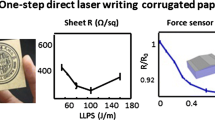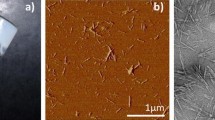Abstract
In an earlier work we reported the discovery of cellulose as a smart material that can be used in sensors and actuators. While the cellulose-based Electro-Active Paper (EAPap) actuator has many merits – lightweight, dry condition, biodegradability, sustainability, large displacement output and low actuation voltage – its performance is sensitive to humidity. We report here on an EAPap made with a cellulose and sodium alginate that produces its maximum displacement at a lower humidity level than the earlier one. To fabricate this EAPap, we dissolved cellulose fibers into a aqueous solution of NaOH/urea. Sodium alginate (0, 5 or 10% by weight) was then added to this cellulose solution. The solution was cast into a sheet and hydrolyzed to form a wet cellulose-sodium alginate blend film. After drying, a bending EAPap actuator was made by depositing thin gold electrodes on both sides of it. The performance of the EAPap actuator was then evaluated in terms of free displacement and blocked force with respect to the actuation frequency, activation voltage and content of sodium alginate. The actuation principle is also discussed.









Similar content being viewed by others
References
Bazhenov VA (1961) Piezoelectric properties of woods. Consultants Bureau, New York
Chen Y, Zhang L, Gu J, Liu J (2004) Physical properties of microporous membranes prepared by hydrolyzing cellulose/soy protein blends. J Membr Sci 241:393–402
Fukada E (2000) History and recent progress in piezoelectric polymers. IEEE Trans Ultrason Ferroelectr Freq Control 47:1277
Gindl W, Konnerth J, Schoberl T (2006) Nanoindentation of regenerated cellulose fibres. Cellulose 13:1–7
Klemm D, Heublein B, Fink HP, Bohn A (2005) Cellulose: fascinating biopolymer and sustainable raw material. Angew Chem Int Ed 44:2–37
Kondo T, Togawa E, Brown Jr RM (2001) Nematic ordered cellulose: a concept of glucan chain association. Biomacromolecules 2:1324–1330
Kim J, Seo YB (2002) Electro-active paper actuators. Smart Mater Struct 11:355–360
Kim J, Song CS, Yun SR (2006a) Cellulose based electro-active papers: performance and environmental effects. Smart Mater Struct 15:719–723
Kim J, Yun S, Ounaies Z (2006b) Discovery of cellulose as a smart material. Macromolecules 39:4202–4206
Osawa T, Matsubara Y, Muramatsu T, Kimura M, Kakuta Y (2005) Crystal structure of the alginate (poly α-L-guluronate) lyase from Corynebacterium sp. at 1.2 Å resolution. J Mol Biol 345:1111–1118
Shahinpoor M (2003) Ionic polymer-conductor composites as biomimetic sensors, robotic actuators and artificial muscles – a review. Electrochim Acta 48:2343–2353
Wong TY, Preston LA, Schiller NL (2000) Alginate lyase: review of major sources and enzyme characteristics, structure–function analysis, biological roles, and applications. Annu Rev Microbiol 54:289–340
Yan H, Tomizawa K, Ohino H, Toshima N (2003) All-solid actuator consisting of polyaniline film and solid polymer electrolyte. Macromol Mater Eng 288:578–584
Zhang L, Ruan D, Gao S (2002) Dissolution and regeneration of cellulose in NaOH/Thiourea aqueous solution. J Polym Sci Polym Phys 40:1521–1529
Zhou D, Zhang L, Zhou J, Guo S (2004) Cellulose/chitin beads for adsorption of heavy metals in aqueous solution. Water Res 38:2643–2650
Acknowledgement
This work was supported by Creative Research Initiatives (EAPap Actuator) of MOST/KOSEF.
Author information
Authors and Affiliations
Corresponding author
Rights and permissions
About this article
Cite this article
Kim, J., Wang, N., Chen, Y. et al. Electroactive-paper actuator made with cellulose/NaOH/urea and sodium alginate. Cellulose 14, 217–223 (2007). https://doi.org/10.1007/s10570-007-9111-6
Received:
Accepted:
Published:
Issue Date:
DOI: https://doi.org/10.1007/s10570-007-9111-6




